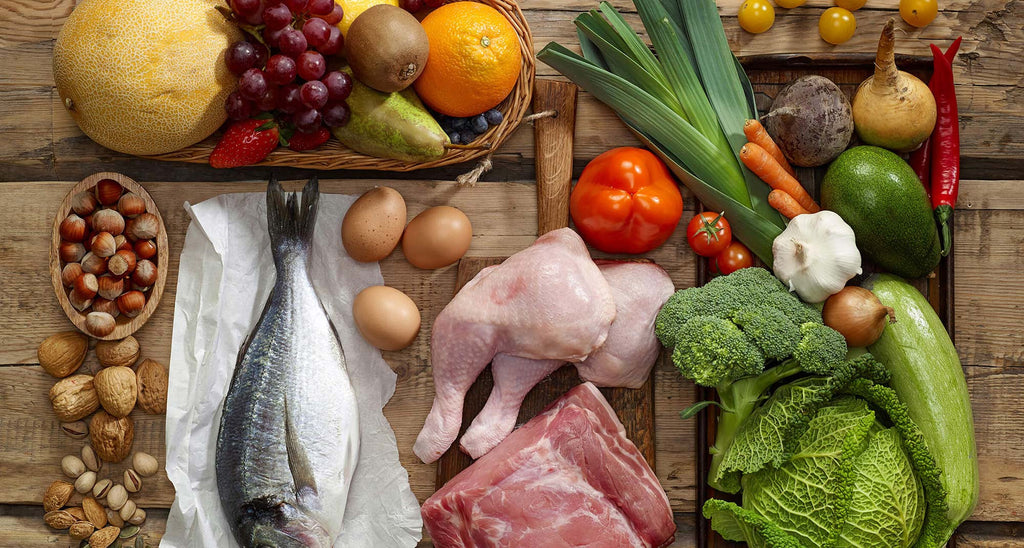
Let’s face it, eating healthy can be a challenge. With so many options to choose from, whether it’s a restaurant or grocery shopping, finding the right foods can be downright hard. In fact, according to FMI, the voice of retail food, in 2015, supermarkets held an average of 39,500 items. That is a lot to choose from. When it comes to restaurants, the choices are even harder. According to Statista, there are over 620,000 restaurants in the United States as of the fall of 2016. That does not necessarily include fast food and convenience stores. The abundance of food available is unprecedented, and one of the many causes of the obesity epidemic in the United States, and the world for that matter. Thus, eating well can be a genuine challenge due to the sheer abundance of food available. Many people believe the Paleo Diet is the better way.
What is The Paleo Diet?
According to the website Health, “The paleo diet (also nicknamed the caveman diet, primal diet, Stone Age diet, and hunter-gatherer diet) is hugely popular these days, and goes by one simple question: What would a caveman eat?” In other words, the paleo diet focuses on what you would eat if your modern lifestyle and abundance of food choice simply disappeared and all you had left was to hunt and gather like our caveman ancestors. All you had to rely on was your ability to find your own food in the foliage, lakes, and animals that you lived with. And we are not discussing dinosaurs because they would make you their paleo diet.
What Did Cavemen Eat?
Cavemen lived in the Paleolithic era, which is where the name for the Paleo Diet came from. According to Britannica, the encyclopedia, this era was around 2.6 million years ago. In this era, tool making was in its infancy, which would have meant rocks sharpened to make knives. This would affect how cavemen would hunt and gather and what they would eat. According to Slate, “They definitely ate fruit. Last year, paleoanthropologists found bits of date stuck in the teeth of a 40,000-year-old Neanderthal. There's evidence that several of the fruits we enjoy eating today have been around for millennia in much the same form.” Caveman would not have a problem meeting the daily fruit requirements of today with apple trees, oranges, figs, and many other fruits available depending on where in the world they were. Caveman ate meat as well. According to The BBC, they would have had access to many fish and animals from foxes, squirrels, and wolves in Britain. And depending on where they lived, they would have access to different animals, land and sea for their food. Vegetables were a different story as they were not as edible as they are with today's modification processes. For example, Slate mentions how carrots would not have been recognizable to us today from how they looked then.
What Does the Paleo Diet Consist of Today?
While the paleo diet is based on the idea that you eat as if you were in the stone age, no one expects you to mimic their exact methods for gathering and cooking. That means the variation of what you would be eating on a modern paleo diet is going to be slightly different. You follow the basic tenets below according to Authority Nutrition with today's paleo diet recommendations.
Eat: Meat, fish, eggs, vegetables, fruits, nuts, seeds, herbs, spices, healthy fats and oils.
Avoid: Processed foods, sugar, soft drinks, grains, most dairy products, legumes, artificial sweeteners, vegetable oils, margarine and trans fats.
Avoid these foods and ingredients:
- Sugar and high fructose corn syrup: Soft drinks, fruit juices, table sugar, candy, pastries, ice cream and many others.
- Grains: Includes breads and pastas, wheat, spelt, rye, barley, etc.
- Legumes: Beans, lentils and many more.
- Dairy: Avoid most dairy, especially low-fat (some versions of paleo do include full-fat dairy like butter and cheese).
- Vegetable Oils: Soybean oil, sunflower oil, cottonseed oil, corn oil, grapeseed oil, safflower oil and others.
- Trans Fats: Found in margarine and various processed foods. Usually referred to as “hydrogenated” or “partially hydrogenated” oils.
- Artificial Sweeteners: Aspartame, Sucralose, Cyclamates, Saccharin, Acesulfame Potassium. Use natural sweeteners instead.
- Highly Processed Foods: Everything labelled “diet” or “low-fat” or has many weird ingredients. Includes artificial meal replacements.
A simple guideline: If it looks like it was made in a factory, don’t eat it!
Base your diet on these real, unprocessed paleo foods.
- Meats: Beef, lamb, chicken, turkey, pork and others.
- Fish and Seafood: Salmon, trout, haddock, shrimp, shellfish, etc. Choose wild-caught if you can.
- Eggs: Choose free-range, pastured or omega-3 enriched eggs.
- Vegetables: Broccoli, kale, peppers, onions, carrots, tomatoes, etc.
- Fruits: Apples, bananas, oranges, pears, avocados, strawberries, blueberries and more.
- Tubers: Potatoes, sweet potatoes, yams, turnips, etc.
- Nuts and Seeds: Almonds, macadamia nuts, walnuts, hazelnuts, sunflower seeds, pumpkin seeds and more.
- Healthy Fats and Oils: Lard, tallow, coconut oil, olive oil, avocado oil and others.
- Salt and Spices: Sea salt, Himalayan salt, garlic, turmeric, rosemary, etc.
With all of this in mind, the diet may sound a bit bland to put it kindly, which is why we wanted to suggest some foods to eat on the Paleo diet to make it more palatable. Seeing the ingredients in raw form may seem hard. How do you take these items and make them into something enjoyable that you want to eat? After all, with all the options available to you, how are you going to match the taste and texture of what you can get in the supermarket frozen food and pre-made food section, or that restaurant chain or local food place you love? Below are some ideas.
Anything Eggs
 Eggs are the easiest thing on the paleo diet to eat. You can make them in a variety of ways such as an omelette, over easy, in the over, or more. Frittatas are one great example. Beat some eggs and pour them into a pan with your favorite vegetables. Then bake them until they are too hard to resist.
Eggs are the easiest thing on the paleo diet to eat. You can make them in a variety of ways such as an omelette, over easy, in the over, or more. Frittatas are one great example. Beat some eggs and pour them into a pan with your favorite vegetables. Then bake them until they are too hard to resist.
Crock Pot Roasts
 Roasts are not only great to spread a tight budget, but they taste great. You can put some beef and vegetables into a crock pot and let it cook. You get a nice tender piece of meat falling apart and large enough to feed the family or last a few days.
Roasts are not only great to spread a tight budget, but they taste great. You can put some beef and vegetables into a crock pot and let it cook. You get a nice tender piece of meat falling apart and large enough to feed the family or last a few days.
Roast Chicken
 This is another affordable and easy to make option that tastes great. It may seem hard at first to cook a whole chicken, but once you do it, you will not want to stop.
This is another affordable and easy to make option that tastes great. It may seem hard at first to cook a whole chicken, but once you do it, you will not want to stop.
Chili
Chili is great to warm you up. It travels well, is versatile, you can freeze it, and you can make it in big batches. You can adjust the spice level and throw just about anything in it. This is a real treat on any day!
Chicken Soup
This is a time honored food that soothes the soul. It’s easy to make and nice and healthy, and is a great way to get vegetables in, especially if they are about to go bad.
Eating Paleo does not mean you have to starve. It does not mean you have to give up your favorite basic foods such as meats. It simply means that you have to be a little more careful about what you eat and what is in the items you buy. It is up to you how strictly you follow the paleo diet. We are not here to tell you that you are a bad person if you decide you want a cheeseburger every so often. We are simply here to tell you there is a better way to eat, and this is one option that mimics what cavemen ate. And although they did not have the advantage of modern medicine, we imagine if they did, they would have lived much longer lives. We believe this because all the foods in the paleo diet are foods that are generally good for you to eat, and it takes much of the guessing out of trying to pick from the thousands of options that try to sell you on how their food is the best, when it may not be.
At Elevation Gourmet, we take your health seriously, which is why we will soon be offering paleo friendly, no sugar added ketchup. We are excited for this product so you can enjoy some extra "umph" on your paleo meals and make them more enjoyable.
Happy hunting and gathering!
